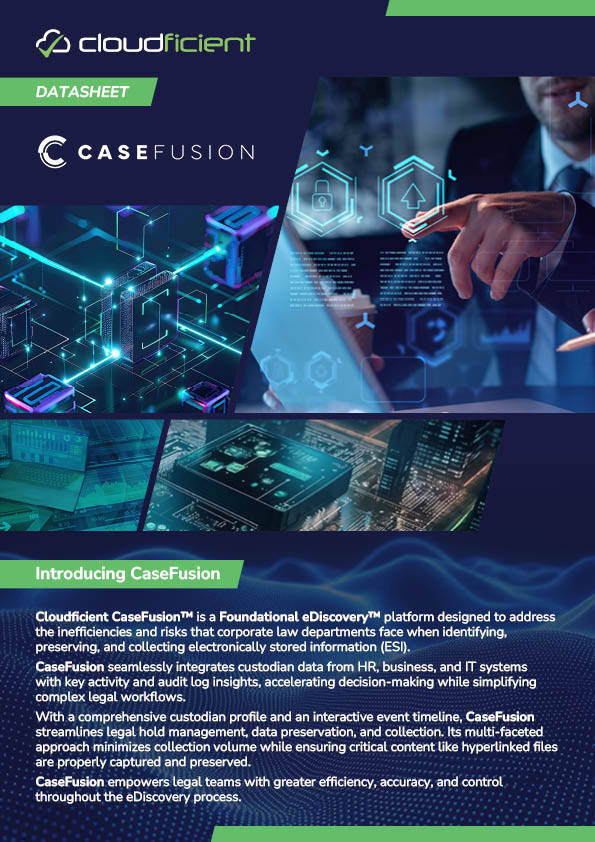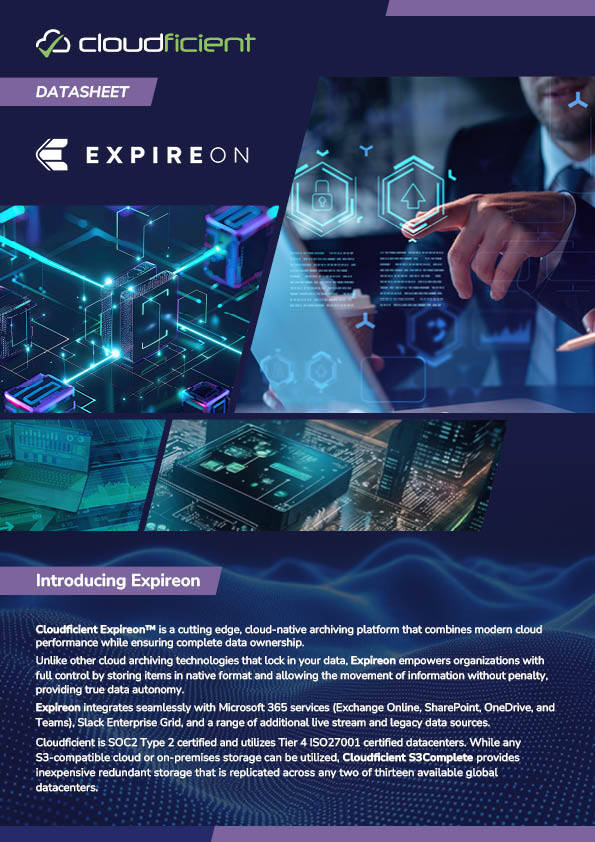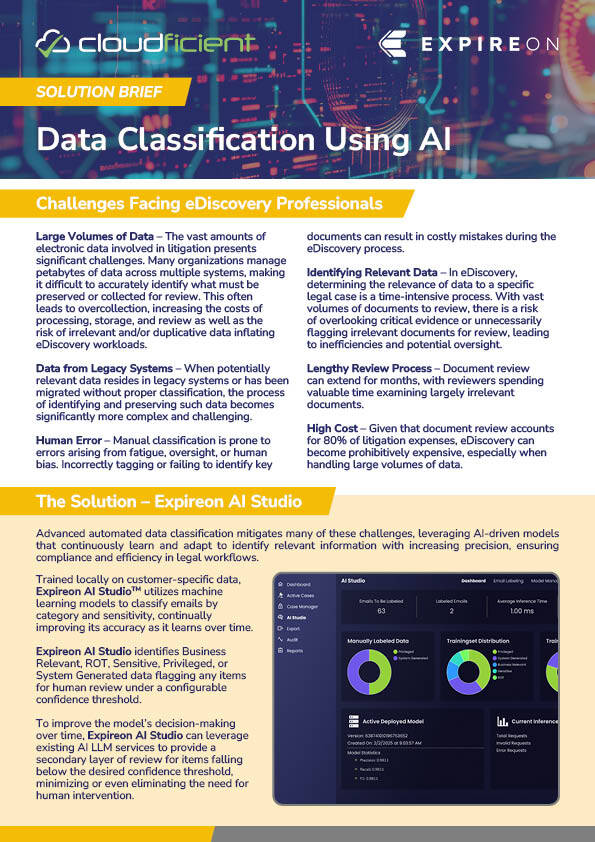- Solutions
- Foundational eDiscovery
- Evidence Preservation & Collection
Preservation of Evidence for Electronic Data Collection
Organizations face mounting risks when preservation of evidence protocols fail to address the complexity of modern electronic data collection across distributed enterprise environments. Traditional approaches to digital preservation expose legal teams to devastating spoliation sanctions while struggling to capture contemporaneous data across cloud platforms, mobile devices, and legacy systems that require specialized forensic collection methods.
What to Consider During Digital Preservation for Forensic Collection
Effective electronic data collection requires immediate, automated preservation protocols that prevent spoliation while ensuring the integrity of digital preservation across your entire data ecosystem. Modern organizations must establish protocols for contemporaneous evidence capture to maintain defensibility throughout litigation while using intelligent data collection to reduce review costs. Without integrated preservation strategies, organizations face increased legal exposure from incomplete evidence collection and compromised chain of custody standards.
Spoliation Risks & Contemporaneous Data Loss
Modern organizations face significant spoliation risks when digital preservation protocols fail to capture contemporaneous versions of live data in real-time. Critical evidence can be lost through automated deletion policies, system updates, or inadequate electronic collection procedures. Organizations struggle with:
-
-
Contemporaneous preservation gaps: Delays between preservation triggers and actual data collection make it possible for critical evidence to be permanently lost.
-
Automated deletion conflicts: Routine system maintenance and retention policies continue during litigation, risking spoliation claims.
-
Version control complexity: Dynamic documents and collaborative platforms create multiple versions of the same data, requiring specialized digital preservation methods to maintain integrity.
-
Cross-platform dependencies: Electronic data collection must account for hyperlinked content and integrated systems where traditional preservation methods fail.
-


Electronic Data Collection Complexity Across Enterprise Systems
Enterprise environments present unique challenges for electronic data collection that require sophisticated digital preservation strategies. Organizations lack visibility into distributed data ecosystems where critical information resides across multiple custodians and geographic locations. Key challenges include:
-
Fragmented data sources: Electronic data collection must span email systems, cloud platforms, mobile devices, and legacy databases that lack unified preservation workflows.
-
Forensic collection requirements: Specialized digital preservation methods are needed to maintain the chain of custody and data integrity for admissible evidence.
-
Real-time data evolution: Active business operations continuously generate and modify data, requiring contemporaneous preservation approaches that capture live information.
-
Scalability limitations: Traditional data collection methods cannot efficiently handle the volume and velocity of modern electronic data generation.
Data Preservation Across Hybrid Cloud Environments
Cloud-first organizations face unique digital preservation challenges when data spans on-premises systems, multiple cloud providers, and hybrid architectures. Traditional preservation captures 40-50% too much data, raising costs, and forcing organizations to account for:
-
Multi-tenant security concerns: Cloud-based data preservation needs to maintain strict access controls while still enabling forensic collection across shared infrastructure.
-
Jurisdiction complications: Global data residency requirements across international boundaries complicate data preservation.
-
API Limitations: Cloud platform restrictions can prevent comprehensive electronic data collection, creating gaps in digital preservation coverage.
-
Service provider dependencies: Organizations rely on third-party platforms for data preservation capabilities they cannot directly control or audit.

Legacy System Digital Preservation & Forensic Gaps
Organizations struggle with electronic data collection from outdated systems that lack modern preservation capabilities and API connectivity. Legacy databases, email archives, and file servers often contain critical historical evidence but require specialized forensic collection methods to ensure data integrity. Key preservation challenges include:
-
Proprietary format complications: Older systems store data in formats that modern electronic data collection tools cannot process, risking incomplete data preservation.
-
System instability risks: Legacy infrastructure may fail during forensic collection attempts, permanently losing contemporaneous evidence.
-
Integration barriers: Disconnected systems prevent unified data preservation workflows, creating silos that complicate comprehensive electronic data collection.
-
Technical expertise requirements: Specialized knowledge needed for legacy system preservation often exceeds internal capabilities, delaying critical data collection efforts.
Mobile Device & Remote Work Data Preservation Complexity
The shift to distributed workforces makes electronic data collection increasingly difficult across personal devices, cloud-synchronized files, and messaging platforms. Organizations lack visibility into employee-controlled devices and applications where their business-critical data resides. Remote work preservation challenges include:
-
BYOD policy conflicts: Personal device preservation must balance legal obligations with privacy rights, which complicates forensic collection procedures.
-
Application sprawl: Employees use unauthorized platforms for business communications, creating preservation preservation blind spots in electronic data collection.
-
Synchronization timing: Cloud-synched data creates multiple copies across devices, requiring contemporaneous preservation to prevent version conflicts.
-
Geographic distribution: Remote employees across jurisdictions complicate data preservation protocols and forensic collection logistics.


Regulatory Compliance & Cross-Border Data Preservation
Global organizations face conflicting regulatory requirements that complicate digital preservation and electronic data collection across international boundaries. Privacy regulations such as GDPR clash with litigation preservation duties, creating legal risks regardless of the chosen approach. Compliance challenges include:
-
Conflicting legal obligations: Data protection laws may prohibit preservation activities required for litigation, creating impossible compliance scenarios.
-
Transfer restrictions: Cross-border data movement limitations prevent centralized electronic data collection and forensic analysis.
-
Retention policy conflicts: Regional requirements for data deletion contradict preservation needs, risking both privacy violations and spoliation claims.
-
Audit complexity: Demonstrating contemporaneous compliance across multiple jurisdictions requires sophisticated documentation and reporting capabilities.
Implement Contemporaneous Digital Preservation Protocols
Establish automated systems that trigger immediate data preservation upon the anticipation of litigation, ensuring contemporaneous capture of electronic data before it can be modified or deleted. Deploy real-time monitoring that suspends automated deletion policies and captures system activity logs. Organizations with robust contemporaneous preservation protocols reduce spoliation risks while maintaining complete digital evidence integrity throughout the litigation lifecycle.
Deploy Comprehensive Electronic Data Collection Frameworks
Leverage integrated platforms that unify data collection across email systems, collaboration tools databases, and cloud platforms through standardized APIs and forensic collection methods. Implement automated custodian identification and data mapping that provides real-time visibility into the preservation status of data across all enterprise systems. Organizations that deploy comprehensive electronic data collection frameworks achieve faster case initiation and more complete digital preservation while reducing manual effort and human error.
Establish Forensic Collection Standards for Digital Evidence
Create defensible forensic collection procedures that maintain chain of custody, preserve metadata, and ensure data integrity throughout the electronic data collection process. Implement specialized tools for database preservation, mobile device imaging, and cloud platform extraction that meet court admissibility standards. Organizations with established forensic collection standards strengthen their litigation positions while reducing challenges to evidence authenticity and completeness.
Optimize Data Preservation Through AI-Powered Classification
Deploy machine learning algorithms that analyze content context, communication patterns, and reduce review volumes by up to 40% to lower preservation costs. Implement automated classification workflows that identify potentially relevant information early in the preservation process while maintaining digital preservation defensibility. Organizations that leverage AI-powered data preservation achieve significant cost reductions while improving collection accuracy and reducing manual review requirements.
Maintain Continuous Compliance Through Automated Preservation Monitoring
Establish ongoing monitoring systems that track data preservation status, custodian compliance, and electronic data collection completeness across all enterprise platforms. Deploy automated alerts and escalation workflows that ensure contemporaneous preservation requirements are met and maintain detailed audit trails. Organizations with continuous compliance monitoring demonstrate proactive digital preservation efforts and maintain stronger, more defensible positions throughout litigation.
Our Solutions
Cloudficient’s integrated platform eliminates the gaps in Foundational eDiscovery to reduce the traditional risks inherent to preservation approaches. We deliver automated, defensible solutions for electronic data collection and digital preservation across entire enterprise environments.
CaseFusion - Comprehensive eDiscovery platform that reduces review volumes by up to 80% by unifying custodian identification, automated preservation workflows, real-time compliance monitoring, and defensible audit trails to ensure contemporaneous evidence capture across all enterprise systems.
Expireon - Cloud-native data archiving platform that provides seamless preservation of evidence across hybrid cloud environments with native format storage, custom retention policies, RSMF export, and integration with Relativity to reduce downstream review costs by 40%.
Expireon AI Studio - Enhances identification through AI-powered classification and categorization that intelligently analyzes content, identifies key custodians, and reduces review volumes by up to 40% while maintaining discovery defensibility.
Hyperlize - Production analysis platform that validates electronic data collection completeness by identifying missing hyperlinked documents and forensic collection gaps before they become litigation liabilities.
Frequently Asked Questions
What does contemporaneous mean?
Contemporaneous refers to data that exists at the same time as the events in question. In digital preservation, it means capturing electronic data in real-time as it's created or modified, rather than collecting it later. Delays between preservation triggers and actual electronic data collection can result in lost evidence and spoliation risks.
What is the difference between preservation and collection?
Preservation of evidence involves implementing legal holds to prevent deletion or modification of potentially relevant data. Electronic data collection is the actual process of gathering that preserved data using forensic collection methods while maintaining chain of custody. Preservation protects the data first, then collection extracts it for legal proceedings.
What is spoliation?
Spoliation is the destruction, alteration, or failure to preserve evidence relevant to litigation. In digital preservation, it occurs when organizations fail to maintain electronic data through continued automated deletions, system updates, or inadequate electronic data collection procedures. Spoliation can result in severe legal sanctions, making proper contemporaneous data preservation protocols essential.
How does digital preservation work across hybrid cloud environments?
Digital preservation in hybrid cloud environments requires specialized electronic data collection frameworks that access data across on-premises systems and multiple cloud providers through APIs. Key challenges include managing jurisdiction complications, working within platform limitations, and maintaining forensic collection standards across different infrastructure types while ensuring contemporaneous data capture.
What are the biggest risks of inadequate mobile device data preservation?
The primary risks include spoliation claims from missing business communications on personal devices, incomplete electronic data collection due to unauthorized app usage, and contemporaneous data loss from cloud sync conflicts. BYOD policies complicate forensic collection procedures, and geographic distribution of remote workers creates gaps in digital preservation coverage that can expose organizations to legal sanctions.
.png?width=620&height=82&name=Untitled%20design%20(18).png)
.png?width=600&height=79&name=Untitled%20design%20(18).png)
-3.png?width=250&height=33&name=Untitled%20design%20(18)-3.png)






